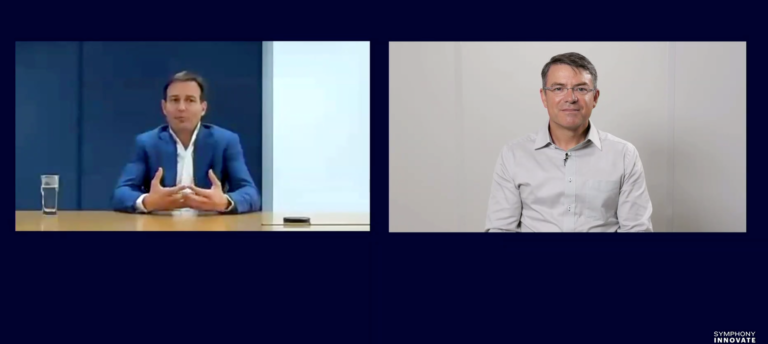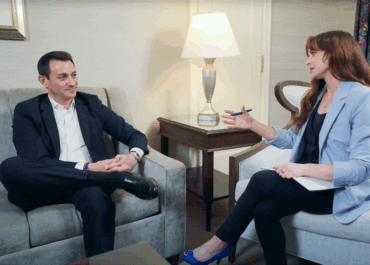David Gurlé, Founder and CEO, Symphony: Now I’m very excited to welcome Benjamin from BFAM. Hi, Benjamin.
Benjamin Fuchs, CEO/CIO of BFAM: David, how are you today?
D. Gurlé: Excellent. Well, thanks for joining us today. And we’re going to spend about twenty minutes together to talk about BFAM, the market, and a bit about BFAM and Symphony. So let’s start with BFAM. What’s BFAM? What are you guys specialized in and how are things going?
B. Fuchs: Sure. And thanks for inviting me to speak with you today. And it’s interesting in the world we live in today. Everyone, we can join together from disparate parts of the world. I’m sure everyone who’s watching this, is in very different locations. So BFAM is quite simply, we’re a Hong Kong based, Asian focused, multi-strategy hedge fund. And what we mean by multi-strategy, is we have distinct sleeves of expertise that we run together in one fund. And those areas are credit, volatility trading and broadly convertible bond trading, and then extending more recently into rates trading.
D. Gurlé: Thank you. One of the characteristics of BFAM, is very technology oriented. We’ll talk more about that, but I will certainly like you to say a couple of words about it, before we go in some of the specific access of BFAM.
B. Fuchs: Sure. On our side, I was just going to say, one of the things that separates BFAM is, we are very Asian focused and Asian centric. And there aren’t a lot of funds that are in technical type products. And especially what we do really lends itself to technologically enabling our users. And I think that, obviously I know we’re going to discuss a lot about that later on and how we’ve been partnering together with Symphony to make sure that we can really enable our users from a technological point of view to take advantage of a lot of the things that are going on in, away from finance and bring those into some of the parts of finance that traditionally have been very, how shall I say, non-tech enabled?
D. Gurlé: So this technology and the strategies that obviously you were liberated over the past few years, have come to play in the COVID-19 times. So going back to January all the way to today in October, what has been the situation and takeaways, from you and your team with respect to what happened in the market?
B. Fuchs: Well, that’s a pretty broad topic, but to narrow it down, I would say this market has created a tremendous amount of opportunity. It’s created the opportunity to misstep and it’s also created opportunity to generate a lot of excess profits. And so, especially for us here in Asia, there has been a great opportunity set. I would say like a lot of people were caught a little bit off guard when COVID first hit and it took us a little bit to adjust and adjust the portfolio. And once we had our head around what was going on, we’ve been able to quite successfully take advantage of the market conditions over the past six months. I think that the biggest challenge is that, historically in trading businesses, it’s quite important to have people really next to each other. It’s not a business where people are really working on their own with the computer. A lot of our core business, it’s quite critical to have people near each other. And so I think we definitely had to push the limits of what we were doing on all aspects of the technology front to, keep the business operating seamlessly.
D. Gurlé: I’m sure everybody is wondering whether you have found the alpha, a sustainable alpha in this time, have you?
B. Fuchs: Well, I would say we found alpha. I don’t know if it’s sustainable, hopefully COVID-19 goes away, and the things that are creating the opportunities that don’t stick around, but more to your point. I think for us, we’re lucky in that our business has grown up in Asia where we’ve had a lot of what we’d call, frictional disequilibrium, over the last 20 and 30 years relative to what people in Western markets are used to. So while COVID was definitely something we weren’t expecting, we’ve seen a lot of market turbulence of this nature historically. And I think that is an environment where we can perform quite well, generally.
D. Gurlé: Thank you. We are about to embark on this post COVID era, American elections, lots of opportunities and I’m sure challenges. How are you preparing BFAM, to seize opportunities and overcome those challenges?
B. Fuchs: So from a business perspective, there are a lot of things we’re doing on the technology front. I think things that we had done, and actually a lot of the things we did together with Symphony, both at the very basic level of what we’ve done with Symphony, but even then at the more advanced level, are things that really differentiated us through the crisis. I’ll give you an example. We’re using Symphony as our core communication platform between our administrator and our prime brokers and ourselves instead of sending emails all over. So when India went to work from home, I think we would have been in a really tricky spot, if we didn’t already have that set up where these chat rooms worked seamlessly. And there’s not really another platform where you can easily do that with the banks.
Of course, there are a lot of platforms, where outside of the bank, you can do that. And I think obviously that’s one of the strengths of Symphony having been set up by the bank consortium to operate in that environment. And so I think that definitely gave us a competitive advantage in terms of a lot of logistical and operational challenges that we were all facing, especially in March and then in April. And so I think we want to continue to build on those types of tools to take what we’ve learned, from having a lot of people out of the office, and just integrate that into a much more seamless process.
Such that we will be quite indifferent, whether people’s operations or a lot of the non-investment part of the business is sitting together in our office or operating from disparate parts of the world. I think we’re set up to handle that quite well at this point. So post COVID-19, if everyone comes back to the office in terms of our counterparties, that will be fantastic. And if they choose not to, I think we’re quite ready to interact with people on that basis as well.
D. Gurlé: Any opportunities and challenges around the U.S. Elections that you are preparing for?
B. Fuchs: Not so much for us, to be honest. We think it’s a non event, just in terms that if the current president is reelected, we know what we’re getting, we’ve just had four years of it. And if the challenger, Joe Biden is elected, I don’t think he’s going to bring in particular radical solutions and he’s by definition, someone who’s going to move things back to the center. So I’m not sure that election from a market’s perspective really changes anything. And I think the federal reserve policy and how they behave and the course of the virus, whether that continues to petered off or whether it becomes a much more dominant feature, those things are going to be much more critical than who the president is, in our view.
D. Gurlé: That’s a very great way of looking at it. I know that BFAM uses technology heavily and you have, by the way, amazing engineers who we have the opportunity to work with. And then they’ve shown us great innovations all the time of our relationship. Can you explain why technology is so important to your organization and where exactly it makes a difference?
B. Fuchs: So that’s a really good question. And it’s interesting for us, because if you think about the investing landscape, there are the traditional black box quant type of funds, and they clearly have always been about technology first and foremost. But if you move into more complex strategies where BFAM operates, it’s really historically, and I would say for the foreseeable future, continues to be primarily a human capital led process. And in terms of the ultimate decision-making is being done hopefully by well-informed humans. And so really what our goal, David, with technology is, is really to enable humans to assimilate information more quickly, more efficiently, have smarter filtering in what they’re looking at, smarter ways to interact with the outside world, all sorts of things that we can do. Whether it’s from neural networks and machine learning and big data type of things, even more basic, type of making communication more effective instead of having people have to type what they want to say, already knowing what their different pattern of conversation is.
And they can just send what they want to say in a much quicker, more efficient way. And so technology for us is I would say, I like to call us the “iron man approach.” If you’ve seen the movie, you have this very powerful suit, but if you don’t have a smart human inside, moving it around, the suit’s just kind of inert and doesn’t do a lot for you. And that’s really the process. And what we’re trying to accomplish at BFAM is to build that smart suit that, combined with the talented humans, you get a multiplier effect into your business. And I really believe that if you’re not doing this and you and I have discussed this a lot, David. The curve is moving out quickly. And if you don’t want to be left behind, the bare minimum you need to do to keep up in a sense to make sure that if you’re a dominant firm today, you’re a dominant firm tomorrow. There’s no question in my mind that you need to be adapting all these types of techniques.
D. Gurlé: You talked about machine learning, you talked about neural networks. I know you are investing in this area. Where do you think we are in terms of the value add of these technologies today, and where do you think they are going to go in the next 18, 24 months?
B. Fuchs: Distinctly for complex trading strategies? I think we’re still in the very early days of really moving the needle and compared to say, simpler strategies like equities, which are definitely dominated by the machines. And so I think if we started about three years ago, trying to implement some of this stuff into our business, and I would say, we’re just now getting to the level where we have a few things that we feel confident enough about actually rolling out lifetime into our process. We would expect that to continue to grow over the next 24 months. So that is a big focus for us. But as you know, ultimately with R & D, it’s really hard to predict the timing on it. And the financial markets continue to not provide, great… The signal to noise ratio is not so good. So you get a lot of misleading or fake signals. And that’s, I think the number one challenge everyone faces in finance.
D. Gurlé: You know, I’m going to take us to Symphony in a minute, but I know that many organizations are trying to take advantage of the analytical capabilities of machine learning to address exactly the point that you just did. Which is, how do you really separate signal from noise and how do you find the right signal? Do you think there has been progress made in this area, compared to like two years ago, or it’s still very much of a research and not yet development?
B. Fuchs: I can just speak for ourselves. I think we’ve gotten much better at having the machines winnow out and get rid of irrelevant information. But you still need the human to put things together. And I’ll give you an interesting example, just in a simplistic sense. When COVID was happening, and first started off in Wuhan, there was a lot of interest in mobility data, and a lot of things in trying to figure out how bad was this virus, really? How many people are going to the hospital in China and all these things? And it’s interesting, because it turns out that there are certain things in China that are blocked in terms of what you can track from the mobility and GPS, et cetera, et cetera. And obviously military bases, but hospitals are also blocked out, right?
And so the machines themselves… You couldn’t just say you have the machine figure out where the hospitals are and figure out what the traffic was, but it turned out that in almost every hospital in China, there was a flower shop. Okay? And the data coming out of flower shops, transaction data, et cetera, et cetera, was not blocked. Right? So there’s all this big data, but it took a human to say, “Hey, what are the things that we could do to find out, actually what’s a proxy that could tell us that information.” And then from looking at transaction data, in those flower shops, in those hospitals, you could get a sense, wasn’t perfect, of how much activity was changing. Right? And I think that’s a great example of like, “Yes, there’s this big data, and you can have all these machines doing it.” There is no machine that would have figured that out.
You had to be a human to understand how a hospital and a flower shop and why those might be connected. And that’s not something you can use self reinforcement learning or all these things. And so I still think for a lot of what we ultimately want to do… Pointing the machine in the right direction, that still takes a human quite often.
D. Gurlé: It’s an excellent example. And one of the documentaries I watched on artificial intelligence was pointing out to that correlation you just made as common sense. As this thing that we as humans instinctively implicitly do without any particular thought process, connect, while machines have not obviously learned the consciousness and the common sense that follows consciousness to achieve that degree of correlations. This takes us to a bit of Symphony domain. Obviously we’ve been partnering for some time with you and obviously with your team, and thanks a lot for leading us in the right direction, with respect to the workflows that we’ve also talked about and we will talk about today in Innovate. The question I have for you is, what’s been for you the trigger, to work with Symphony and what really has Symphony helped you to achieve beyond what you talked about earlier on, obviously with respect to bringing people closer as when they are remote.
B. Fuchs: So one of our frustrations, or one of my frustrations for a very long time, is a lot of our business is transacted over the counter. And there’s no easy way to just electronically transact and settle. And we have just for reference, we have, let’s call it 85 people, here at BFAM, in and around the core fund business, away from the researchers and stuff in AI. And if you look down our trading floor, you would see on any given time, a couple years ago, tons of people, or not tons, only 85, but tons of people busy typing in all day. They’ll be sitting in there just being professional typists all day. You have an idea, you want to get it executed. And then thinking up the idea might take 10 minutes and getting it implemented might take an hour, just because the markets are so efficient by the time you, “Oh, Hi. How are you, David? I would like to do this.” “Oh, okay. Blah, blah, blah, blah.”
And you talk to 10 brokers and you get them trades, and then you have to book it in your system and you have to let your middle office know. And it’s like, we want our people and myself, we want to spend our day thinking at the high level ideas, the things we talked about, the machines can’t do. And so we were really looking for a solution. How do we get rid of cut and paste in this kind of a typing into the machine to transact? And we really couldn’t find any solutions that were suitable for our businesses. And part of that is because we’re in relatively niche businesses. So there isn’t necessarily a huge product demand. You’re not going to have a billion users that want to trade OTC equity vol for better or worse.
So, we needed a way that we could interact. We were also constrained by what the banks, how they would allow us to communicate with them. And so that led us, this was a year and a half ago, I think December of 2018 was when I first heard of Symphony. And we tried a bunch of different things. We tried to work with Bloomberg. We figured out ways to hack into the Bloomberg chats and the Snap, but you couldn’t really get the information that you needed or communicate in this, to be able to communicate in a structured way. And so Symphony really provided us and ticked the most number of boxes for us to replace a lot of that manual process. And we built something. I think Johan, who is our lead developer, spoke last year in Singapore, I think at the same forum or conference and discussed what we did.
And we built what we call a vall chatbot that allows us to pretty seamlessly replace a lot of that human communication that was happening with a structured way of exchanging that information more efficiently. Such that it much more emulates what you would expect to see if you were trading a stock where you just push a button on your machine, and it goes into the market, and it gets executed. It comes back and it goes into the settlement system. And no human has ever touched it once you put in the order. And so we’re trying to find a way to replicate that. And that’s how we got Symphony. We had a meeting, we were able to move things pretty quickly. We did a lot of development work together with your team and then began the process of onboarding banks and pressuring them to… We built, I guess, an app that’s in the Symphony app store that the banks could download to enable us to transact in a more technology enabled way.
I keep using the same word, because I haven’t thought of a better way to say it. And we continue to expand our product subset. So we’ve just rolled out India forwards and a bunch of other OTC products. And we’re slowly moving through the shopping list of all the things that we trade OTC, and trying to get them on to this platform so that we can do it electronically and reduce a lot of the typing and chat monitoring and all these things that the humans should be spending their time doing other things.
D. Gurlé: This has indeed been an incredible journey together, Benjamin. I still remember the early conversations we had and look at where we are today. You are running a portion and a significant portion already of your business on Symphony. And not only you’ve done that, but you’ve also inspired us and inspired the brokers and the whole community. And actually it’s really helped us to catalyze this idea of SPARC, which obviously for us generalizes some of the, I would say, solutions that you have with Johan and the team have built, with respect to pricing discovery, with respect to liquidity discovery and automating those so that your organization is focusing on higher order activities, in order to make such correlations between flowers and what’s going in China, for example. So just in a few words, as we wrap up our session, how do you see our relationship moving forward and how can we make you more efficient and help you generate even greater alpha?
B. Fuchs: So I think there’s two pieces of that. I mean, the reality is we’re all captive to the banks. To the speed with which they’re willing to innovate and enable things on their desk and support them. I think that’s been our biggest challenge. And so in where we first started, David, which was equity vol we’re one of the largest customers in Asia. So people kind of fell in line and they’re like, “It wasn’t that much work for them to do it.” We can see that in other areas though, it’s been very difficult to get the banks a lot of times to cooperate on how they send us runs, how they send us axes. Our original goal was really to, I would say, replace the Bloomberg IB chat as our main trading interaction. We’re pretty neutral about using it.
Like if you want to meet for dinner, you could use WhatsApp, you could use Bloomberg chat. It is one neutral platform that all the banks have and people have, and it’s easy to do that type of stuff. But we really don’t want to be doing transactions. We don’t want to be receiving runs. We don’t want to be getting market data via chat format. And I know that’s where Symphony has played a key role for us, as Bloomberg really doesn’t want to give any of that out. That’s where they’re got their monopoly. But banks are the ones originating that data and sending it. And so I would say our biggest challenge right now is convincing the banks to send out a lot of their communication via something like Symphony.
That’s the next big thing that we would like to see is, the banks putting all their runs, all their pricing, all of that, sent through a Symphony type of platform. And then we can electronically ingest that, run our models on it, put it into our database. And once again, not have the human monitoring chats, have the human monitoring ideas and maybe ideas that are generated from that and monitoring the metadata. And what’s coming off from that and potential patterns that there could be that humans will pick up and that machines just probably won’t pick up.
D. Gurlé: Well, we are very happy to partner with you and work hand in hand as we have done in the past, and we will continue to do tomorrow. And I see great progress being made with the whole organization and Brad joining us. I think we are definitely going in the right step, but we could not have done it without you, Benjamin. Thank you very much for being with us today. And I really appreciate all the work, all the partnership. You are giving us the opportunity to be together and looking forward to seeing you in Hong Kong very soon.
B. Fuchs: Thank you, David, stay safe and thanks to everyone who joined in today.



